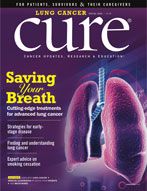Publication
Article
CURE
Under the Radar: Detecting Lung Cancer Among Never-Smokers
Author(s):
Never-smokers are getting lung cancer more frequently, but detecting it at early stages is especially difficult.
As smoking rates have dropped, so have the overall rates of lung cancer in the United States. Yet, lung cancer rates are increasing in people who have never smoked. In fact, today, nearly one in five people diagnosed with lung cancer are never-smokers.
This group includes a higher proportion of women, Asians and people with adenocarcinoma. Causes can include exposure to second-hand smoke, asbestos, radon, coal or certain cooking oils, and genetic susceptibility — most likely a combination of factors. Researchers are also studying whether the human papillomavirus can stimulate lung cancer in never-smokers, and whether the disease can be fueled by estrogen.
As scientists have learned more about lung cancer on the molecular level, they have discovered that lung cancer among never-smokers involves different changes or mutations in the DNA make-up of the tumor — so different, in fact, that some consider it a different disease altogether than that found in longtime smokers.
“We already know of some gene changes in the lung cancers of nonsmokers that are different from those in tumors from smokers. But we don’t know why these changes occur or how they interact with other environmental factors,” says David Carbone, director of the James Thoracic Center of The James Cancer Hospital and Solove Research Institute at the Ohio State University Comprehensive Cancer Center in Columbus, Ohio.
Tumors from smokers have a much higher total number of gene mutations, but mutations in a gene called EGFR are more frequently found in the lung cancers of never-smokers. Identifying this type of mutation is important, because patients who test positive for EGFR mutations or others, such as ALK alterations, can benefit from new lung cancer drugs that are specifically designed to “target” these characteristics. Unlike traditional chemotherapies, these targeted drugs are better at shrinking tumors with these specific mutations and come without most of the toxic side effects of chemotherapy.
Carbone says that never-smokers are far less likely to have their disease caught early, in part because “no one suspects it” and it “rarely presents symptoms” until it’s in the late stages. “You have a couple gallon milk jugs on each side worth of lung capacity, so a tumor can get to be pretty big before it causes any symptoms at all,” he says. Because symptoms of lung cancer like coughing, wheezing and shortness of breath are so similar to common illnesses, they are easily ignored by patients and misdiagnosed by physicians. “Most often people are diagnosed because of the symptoms from the disease having spread — a brain metastasis causing a seizure or bone metastasis causing pain — rather than symptoms from the tumor itself,” Carbone adds.
So, what can be done to catch these cancers early?
C
“Clearly, it does not make sense to do CT screening on an entire population of nonsmokers for lung cancer,” Wakelee points out. Instead, she says, “more research into additional screening tools, like molecular markers in the blood, sputum, urine — are needed.” These tests could help select people who are likely to benefit from low-dose CT screening or help identify those who’ve had positive low-dose CT screening tests who should undergo more evaluation.






